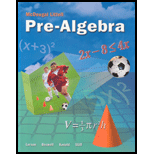
Concept explainers
a.
To describe:the survey’s population and sampling method
a.
Answer to Problem 1C
The residents of the apartment are the population and the sampling method is stratified sampling.
Explanation of Solution
Given information:
“The manager of an apartment building wants to know if noise is a problem in the building. The manager asks one person on each floor if the person thinks noise is a problem.”
The population consist of all the person who are living in the apartment because the manager uses the rule “interview one person from each floor of the apartment”, so, the sampling method is a stratified sample where the population is divided according to their floor and one person is selected from each floor.
b.
To describe:the survey’s population and sampling method
b.
Answer to Problem 1C
This method could not result in a biased sample.
Explanation of Solution
Given information:
“The manager of an apartment building wants to know if noise is a problem in the building. The manager asks one person on each floor if the person thinks noise is a problem.”
This method could not result in a biased sample because each person from each floor could fairly represent the whole population.
c.
To describe:the survey’s population and sampling method
c.
Answer to Problem 1C
Another method of sampling is random sampling and it result in biased sample.
Explanation of Solution
Given information:
“The manager of an apartment building wants to know if noise is a problem in the building. The manager asks one person on each floor if the person thinks noise is a problem.”
Another method of sampling is that the manager can arrange a survey in which he randomly interview 20 persons who passes the entry gate of the apartment. So, the sampling method is random sampling and this method could result in a biased sample as it is not a representative of the population.
b
To explain: the survey could result in biased sample or not
b
Answer to Problem 1C
It will not be a biased sample as it is representative.
Explanation of Solution
Given information:
c
To describe: sampling method the manager could use and this method results in a biased sample or not
c
Answer to Problem 1C
Another method can be systematic sample.it may result in a biased sample as all the floor may not be representatied
Explanation of Solution
Given information:
Chapter 11 Solutions
Pre-Algebra
Additional Math Textbook Solutions
Elementary Statistics: Picturing the World (7th Edition)
Algebra and Trigonometry (6th Edition)
Calculus: Early Transcendentals (2nd Edition)
Calculus for Business, Economics, Life Sciences, and Social Sciences (14th Edition)
A First Course in Probability (10th Edition)
- ?arrow_forwardSolve the equation. Write the smaller answer first. 2 (x-6)² = 36 x = Α x = Previous Page Next Pagearrow_forwardWrite a quadratic equation in factored form that has solutions of x = 2 and x = = -3/5 ○ a) (x-2)(5x + 3) = 0 ○ b) (x + 2)(3x-5) = 0 O c) (x + 2)(5x -3) = 0 ○ d) (x-2)(3x + 5) = 0arrow_forward
- A vacant lot is being converted into a community garden. The garden and a walkway around its perimeter have an area of 690 square feet. Find the width of the walkway (x) if the garden measures 14 feet wide by 18 feet long. Write answer to 2 decimal places. (Write the number without units). Hint: add 2x to each of the garden dimensions of 14 x 18 feet to get the total area for the length multiplied by width.arrow_forwardSolve x-1 x+2 = 12 3 4 Your Answer: Answerarrow_forwardFind the solutions to the following equation 21x²+5x=6 ○ a) -3/7, 3/2 ☐ b) -2/3, 3/7 ○ c) -7/3, 3/2 ○ d) -2/3, 7/3arrow_forward
- Listen Solve the quadratic equation. Write the one solution, do not write x =. 2 x²+6x+9= 0 বarrow_forwardSolve the rational equation 14 1 + x-6 x x-7 x-7 ○ a) x = 1, x = 8 ○ b) x = 1 ○ c) x = 7 ○ d) x = 1, x = 7arrow_forwardSolve the absolute inequality | x + 5 > 3 ○ a) (-∞, -8] U[-2, ∞0) ☐ b) (-8, -2) c) (-2, ∞0) ○ d) (-∞, - 8) U(-2, ∞0)arrow_forward
- 1) Listen Describe the error in the problem X 3 X x 3 - 2 = 25x = 0 25x 25 x = ±5arrow_forwardA falling object travels a distance given by the formula d = 6t + 7t² where d is in feet and t is the time in seconds. How many seconds will it take for the object to travel 115 feet? Round answer to 2 decimal places. (Write the number, not the units). Your Answer:arrow_forwardListen Solve the quadratic equation. Write the smaller answer first. 2 Xx - 5x = 24 x = Α x =arrow_forward
 Algebra and Trigonometry (6th Edition)AlgebraISBN:9780134463216Author:Robert F. BlitzerPublisher:PEARSON
Algebra and Trigonometry (6th Edition)AlgebraISBN:9780134463216Author:Robert F. BlitzerPublisher:PEARSON Contemporary Abstract AlgebraAlgebraISBN:9781305657960Author:Joseph GallianPublisher:Cengage Learning
Contemporary Abstract AlgebraAlgebraISBN:9781305657960Author:Joseph GallianPublisher:Cengage Learning Linear Algebra: A Modern IntroductionAlgebraISBN:9781285463247Author:David PoolePublisher:Cengage Learning
Linear Algebra: A Modern IntroductionAlgebraISBN:9781285463247Author:David PoolePublisher:Cengage Learning Algebra And Trigonometry (11th Edition)AlgebraISBN:9780135163078Author:Michael SullivanPublisher:PEARSON
Algebra And Trigonometry (11th Edition)AlgebraISBN:9780135163078Author:Michael SullivanPublisher:PEARSON Introduction to Linear Algebra, Fifth EditionAlgebraISBN:9780980232776Author:Gilbert StrangPublisher:Wellesley-Cambridge Press
Introduction to Linear Algebra, Fifth EditionAlgebraISBN:9780980232776Author:Gilbert StrangPublisher:Wellesley-Cambridge Press College Algebra (Collegiate Math)AlgebraISBN:9780077836344Author:Julie Miller, Donna GerkenPublisher:McGraw-Hill Education
College Algebra (Collegiate Math)AlgebraISBN:9780077836344Author:Julie Miller, Donna GerkenPublisher:McGraw-Hill Education





